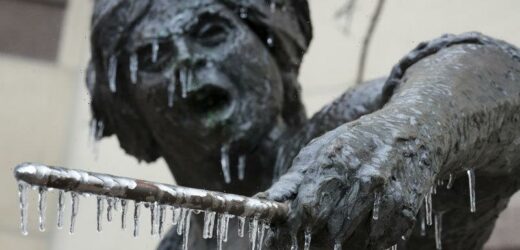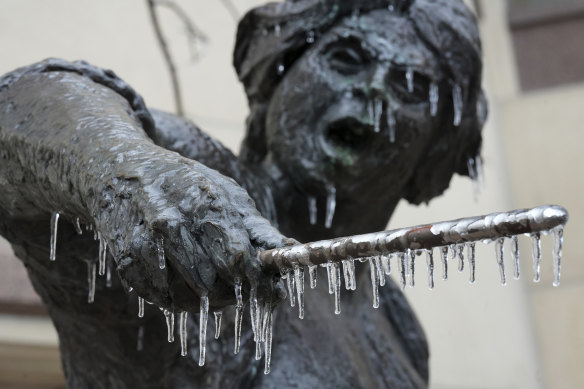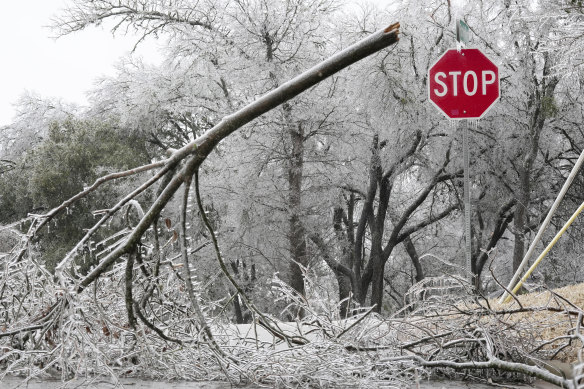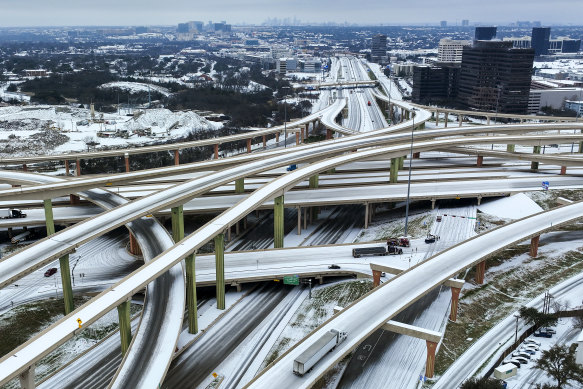Austin, Texas: A mess of ice, sleet and snow lingered across much of the southern US as thousands in Texas endured freezing temperatures with no power, including many in the state capital of Austin.
The deadly storm that is blamed for at least 10 traffic fatalities in three states.
Icicles hang from a statue in downtown Austin, Texas, during a winter storm.Credit:AP
The outages were most widespread in Austin, where frustration mounted among more than 156,000 customers, over 24 hours after their electricity and heat went out.
For many, it was the second time in three years that a February deep freeze caused prolonged outages and uncertainty over when the lights would come back on.
Hundreds more flights were cancelled again in Texas on Thursday (Dallas-time), although not as many as in previous days.
But another wave of frigid weather in the US is on the horizon, with an Arctic cold front expected to move from Canada into the northern Plains and Upper Midwest and sweep into the Northeast by Friday.
A fallen tree blocks part of a street in Austin, Texas, during a winter storm.Credit:AP
The front is expected to bring snow and wind chills lower than minus 45 C to the northern New England region, according to the National Weather Service.
Nearly 430,000 customers in Texas lacked power early Thursday, according to PowerOutage, a website tracking utility reports.
Unlike the 2021 blackouts in Texas, when hundreds of people died after the state’s grid was pushed to the brink of total failure because of a lack of generation, the outages in Austin this time were largely the result of frozen equipment and trees falling on power lines.
The city’s utility warned all power may not be restored until Friday as ice continued causing new outages, even as repairs were finished elsewhere.
“It feels like two steps forward and three steps back,” said Jackie Sargent, general manager of Austin Energy.
School systems in the Dallas and Austin area, plus many in Oklahoma, Arkansas and Memphis, Tennessee, closed Thursday as snow, sleet and freezing rain continued to push through. Public transportation in Dallas also experienced “major delays” early Thursday, according to a statement from Dallas Area Rapid Transit.
Airport crews battled ice to keep runways open. By Thursday morning, airlines had cancelled more than 500 flights at Dallas-Fort Worth International Airport — more than a quarter of all flights scheduled for the day. Still, that was down from about 1300 cancellations on Wednesday and more than 1000 on Tuesday, according to FlightAware.com.
An icy mix covers a highway interchange in Dallas. Credit:AP
Dozens more flights Thursday were cancelled at Dallas Love Field and Austin-Bergstrom International Airport.
Watches and warnings about wintry conditions stretched from the West Texas border with Mexico through Oklahoma, Arkansas and Louisiana and into western Tennessee and northern Mississippi.
And in a briefing Thursday with the federal Weather Prediction Centre, New Englanders were warned that wind chills — the combined effect of wind and cold air on exposed skin — in the minus 50s “could be the coldest felt in decades.”
The strong winds and cold air will create wind chills “rarely seen in northern and eastern Maine,” according to an advisory from the National Weather Service office in Caribou, Maine.
Jay Broccolo, director of weather operations at an observatory on New Hampshire’s Mount Washington — which for decades held the world record for the fastest wind gust — said Thursday that wind speeds could top (160 kph).
“We take safety really seriously in the higher summits, and this weekend’s forecast is looking pretty gnarly, even for our standards,” Broccolo said.
At least ten people have died due to treacherous road conditions since Monday, including seven in Texas, two in Oklahoma and one in Arkansas. Texas Governor Greg Abbott urged people not to drive.
AP
Get a note directly from our foreign correspondents on what’s making headlines around the world. Sign up for the weekly What in the World newsletter here.
Most Viewed in World
From our partners
Source: Read Full Article





